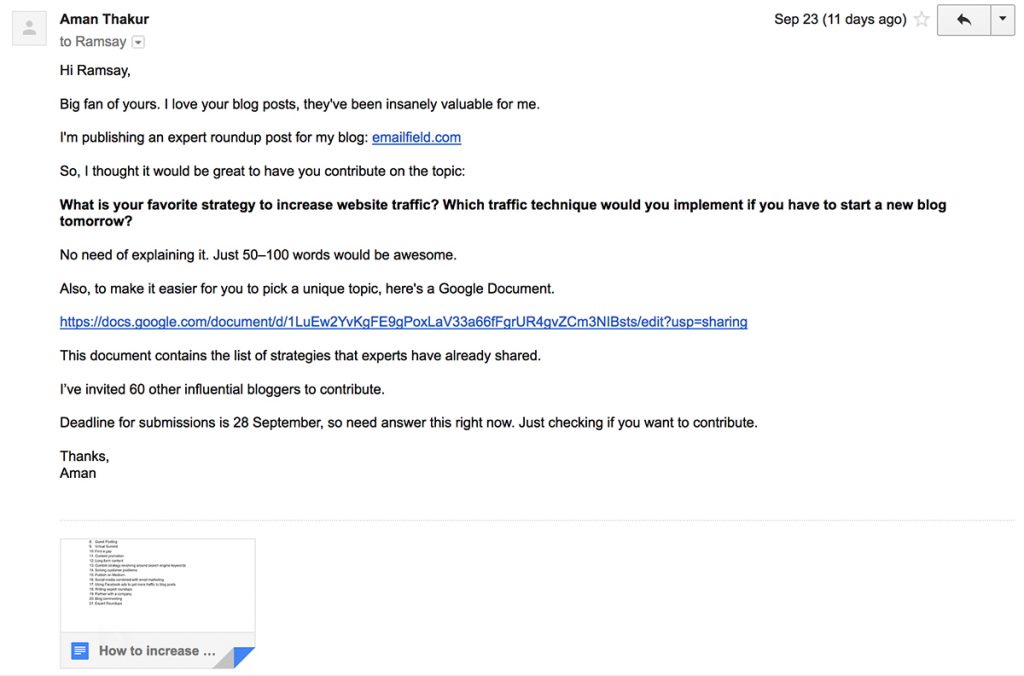Want to learn how to send an email pitch that won’t get deleted? It’s a vital part of online business. Let’s take a look at the graphic first and then get into some details:

Why I’m writing about email pitches
As the owner of a fairly large website, I get dozens of emails everyday from people pitching things. I have colleagues who get hundreds.
While I try to answer every legitimate email I get, I have noticed that there are certain things that really put me off, and certain things that really encourage me to respond quickly.
The same is also true of the emails I send pitching things to others – I always try to pay attention to what works.
And, as the Internet grows, more and more competition means more and more emails getting sent. That potentially means it’ll be harder to cut through and get noticed – especially if you speak a different language to the recipient.
With all of that in mind, I wanted to write about a few simple tips that apply to almost any emailing situation so that newcomers can have a better idea about what works and what doesn’t.
Like my post on things to know before starting a blog, I hope it’ll save a few people some time (and heartache) by avoiding the horrible feeling of getting no replies or getting constantly rejected.
How to send an email pitch
Most of the best tips are included in the infographic above, so I’ll just touch on a few extra points down here. First, let’s start with an example:

I get a lot of these types of requests, and not all of them are as succinct and well thought out as this one. Even though Aman is pretty new to online business he cut through well.
So what did he do right?
- Open with a compliment
Aman starts off with a massive compliment that, as much as I pretend it doesn’t, usually gets me feeling pretty good. I’m so conscious about trying to help people with this site that when someone tells me it has I always get a little buzz. This technique is recommended by a lot of people because it starts the negotiation/request on a positive note. - Straight to the point and a bold question
The next thing he does well is writes his simple question in bold. Generally I know what these emails are about and so I skip to the crux, and it’s nice to be able to identify it quickly. He doesn’t waste any time getting to this with a big backstory about his site or the post. - Time saving mechanisms
The next thing that I really appreciated in this email was that Aman gave a specific deadline, but also included enough time in there for me to take a few days. He also cleverly added an updated Google Doc so I could see what others had contributed in order to prevent repeats. This is an idea I might borrow. - Social proof
Towards the end he adds a line mentioning that there are 60 other people contributing. This is always a clever idea because it makes you think that it’s a legitimate site if so many people have agreed to participate already. Adding social proof in some subtle form is often a good idea. - He understands what it’s like
The major thing I like about this email is how Aman clearly understands what it’s like for online business owners who are busy and get a lot of emails. The whole email is built around being convenient for the recipient and, although he’s asking me to write a paragraph, it feels like there is no work to do.
While it’s not the “perfect” email, I would rate this as one of the better ones that I’ve received in the last month or so and think we can all learn from it.
A bonus tip for email pitches
One last thing I wanted to talk about in this article is the idea giving something before you receive. It is a very powerful tool when you are sending an email like this.
For example, in the blogging world we all thrive off of back links. When someone links to Blog Tyrant they instantly get on my radar – it’s like a form of blogging currency. In this post on blogging strategy I talk about how you can link to someone (or tweet their posts) as a first point of contact before sending an email asking for something.
While this might not be relevant for every email pitch (you don’t want to do it when applying for a job!), it’s often a good idea to look to see if you can give something before asking for something in return.
What kind of emails work for you?
Do you send a lot of email pitches? Perhaps you receive a lot of them yourself? I’d be really curious to know what techniques or styles work for you, or what really puts you off. Please leave a comment below and let me know.
Quick note: If you like the infographic please considering saving it on Pinterest or sharing it on Facebook. That would help me out a lot.
How to Send an Email Pitch that Won’t Get Deleted originally posted at Blog Tyrant
No comments:
Post a Comment